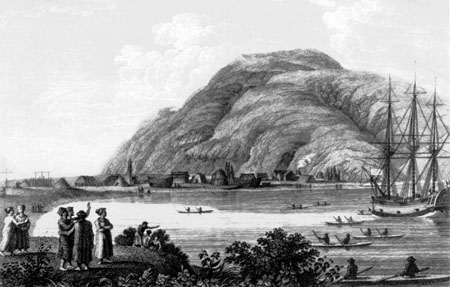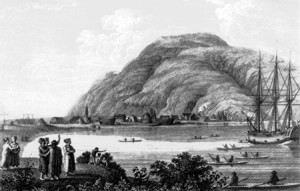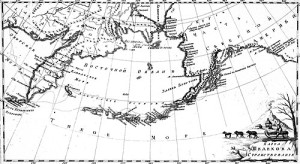Russian Routes: Kamchatka to Kodiak Island

Russian Alaska offers an unusual perspective from which to explore the nature of colonial relations in early North America. In the eighteenth century, when Russia drove outward from Kiev, its empire moved from west to east, first through Siberia, and eventually crossing the Pacific to Alaska. During the 1720s, Tsar Peter the Great enthusiastically initiated and sponsored Vitus Bering’s expeditions into the North Pacific Ocean. The Russian ruler wanted Bering to find out whether the Russian far eastern shore somehow connected to North America and then to forge a path for Russian expansion into that remote region, which held the interest of so many European leaders. On his first voyage, Bering sailed through the strait that now bears his name, thus showing that the Asian and American continents did not connect. During his second voyage, the explorer reached Alaska in 1741, but he died on the way home. The survivors of his second expedition returned to Siberia bringing with them news of “a great land” beyond the eastern ocean. They also brought samples of exquisite sea-otter furs that were much softer than the pelts of any other fur-bearing animal. The interest in these small marine mammals eventually became so intense that it drove Russians across an ocean all the way to Alaska. Kodiak Island became the nexus of Russian activity in America, and the trade in sea-otter pelts would shape colonial relations in the North Pacific during the late eighteenth and early nineteenth centuries.
I.
When Russians first introduced sea-otter furs into their trade with China, they discovered that these pelts could reap profits well beyond those gained from any other type of fur including the fast diminishing Siberian sable. In Russia, news of the profits to be made soon sparked a rush of fur traders across the Kurile and Commander Islands directly off the coast of Kamchatka, the southern peninsula that hangs down from Siberia. Once Russian fur traders had depleted the resources in these islands near the coast, they extended the hunt further east to the Aleutian Islands, and finally, by the 1760s, to Kodiak Island, Alaska. Russians had a head start over other European colonial powers in this part of the world: in 1783, when the Connecticut Yankee John Ledyard published his accounts of the luxuriant sea-otter skins and the tremendous profits to be made from them in his accounts of Captain Cook’s third voyage, Russians had already been acquainted with the sea otters of the North Pacific for half a century.
Still, Russian fur gathering expeditions faced numerous obstacles. Vessels that carried these expeditions commonly went down in the high seas and on average approximately one-quarter to one-third of each venture’s crew perished through disease, warfare, or accident. One of the greatest challenges for the new Russian fur trade, however, was the shift from land-based to sea-based hunting. Promyshlenniki (Russian fur hunters) were adept at the land-based hunting techniques required to catch the Siberian sable, but sea otters had to be hunted in the water. This type of hunting had long been an integral element of Aleutian and Kodiak Alutiiq culture; fathers trained boys to spear animals and to balance small and efficient kayaks in chilly waters, beginning at a young age. The Russians soon recognized that they would gain greater profits if they could convince skilled native men to do the work for them. Russians took native women and children as hostages and forced fathers, brothers, and husbands to bring them valuable sea-otter pelts to assure their families’ safety. They were following a precedent for such forced “collection” of furs as tribute that the Russian Crown had formalized in its administration of Siberia.
As with so many other early European enterprises in the Americas, Russian imperial leaders watched from a distance (in this case, halfway around the world in St. Petersburg) as merchants and hopeful but destitute young men contributed the initial financial and physical investments of imperial expansion. Initially, small companies competed to collect the greatest number of furs in the shortest amount of time. But as the fur supply diminished in one area, fewer companies could afford the far-reaching range of the hunt. By the 1780s, only a few companies remained in the competition. Grigorii Shelikhov, a director of one of these companies, set sail for Kodiak Island, Alaska, where he hoped to establish a permanent settlement that would be more than a mere fur-trading post; he wanted to establish the first overseas colony of the Russian Empire.
II.
In August 1783, three ships departed from Okhotsk carrying 192 men along with Shelikhov, his wife, and two children. One ship was lost at sea, and the two other vessels sailed south out of the Sea of Okhotsk and then north along the Kurile Islands until they reached Bering Island in the Bering Sea. The expedition rested there for the winter. Finally, the two ships arrived at Kodiak Island in August of 1784.
During the first few days of the Russian presence in the bay off Kodiak, two Alutiiq men approached Shelikhov’s ship. He wrote that he and his men welcomed them “with signs of friendship” and, as a sign of good faith, offered them items such as glass beads, tobacco, and, perhaps, needles, with which the people of Kodiak would have been familiar either from earlier Russian arrivals, or through trade with their neighbors.
Despite initial “friendly” advances, Russians eventually pressed the men of Kodiak into work for Shelikhov’s company, after a protracted battle lasting over a month. Russians took women and children hostage, holding them captive in a long cabin along the shore. As the Russians demanded greater numbers of pelts, the sea-otter population around Kodiak soon diminished. Many Alutiiq men drowned as the Russian promyshlenniki forced them to travel further and further away from the island for progressively longer periods of time in perilous weather conditions.
For almost every Alutiiq man who was away on these hunting expeditions, there was a woman who now continued her traditional duties but received no replacement help for male-specific tasks. Russian presence on the island severely disrupted both Alutiiq men’s and women’s daily lives, but in different ways. Alutiiq people had been accustomed to working together in partnerships; now the demands imposed on them by the Russians tore those partnerships apart. Not only were women left at home, often they were taken as hostages for weeks at a time and had to scramble in order to gather enough food for their families to eat. Many Alutiiq people almost starved during the first winters of Russian presence, as neither men nor women had time to provision their own families properly.
From the Russian imperial perspective, the 1790s proved to be a period of great growth for the little colony at Kodiak while the Alutiiq people suffered hardships. The program of expansion under the new company manager Aleksander Baranov, who arrived at Kodiak in 1791, was undoubtedly inspired by Shelikhov’s grandiose plans for an imperial colony. It included not only a new settlement at Kodiak, but also the founding of a settlement at Sitka (later the capital of Russian America) in 1801, the establishment of Fort Ross in northern California (1812) and even efforts to establish Russian outposts in the Hawaiian Islands (1815-17).
In 1792, Baranov moved the fur-trade company headquarters from the southern bay of Kodiak, where the 1784 expedition had first approached the island, to a spot that could provide a deep harbor for trade, timber for building both houses and ships, and land for farming crops that would be pleasing to the Russian palate. The village of Pavlovskaia Gavan, or St. Paul’s Harbor (the present-day city of Kodiak on the northeast side of Kodiak Island) was named for the crown prince of Russia. The new town and initial colonial capital became one of the largest settlements in Russian America, and remained so throughout the Russian era.
III.
At Kodiak, some Alutiiq people likely lived in fear of the Russians, but at the same time the Russians depended on the local knowledge of Alutiiq people for both economic profit and survival. While the Russians relied on native men to supply them with goods for financial profit, the remoteness of the location and lack of familiarity with the local flora and fauna made them rely almost entirely on Alutiiq women for food and daily survival. They also looked to these women for companionship and sex.
Soon after the Russians had arrived on their island, Alutiiq women had also begun working for the company. While men were out on the hunt, women prepared food for the company by drying fish on long poles and collecting berries, as well as making birdskin parkas that the company gave to the Alutiiq people to wear in exchange for their work. Russian Orthodox missionaries, who arrived on Kodiak in 1794, were shocked to find that even women nursing infants were given little leeway, and struggled to satisfy the demands of the company and perform the work that their own survival required.
If Russian men could provide access to food and clothing, and sometimes gifts, it seems likely that at least some native women would have chosen to enter into intimate relationships with them, even though their lives had become more difficult with the arrival of the Russians. Alutiiq women and Russian men had different reasons to form unions with each other. It is most likely that some women were torn from their Alutiiq partners and were sexually abused, others formed “tender” relations with Russian men, and still others chose to enter the relations out of convenience. Some Alutiiq leaders may have encouraged their daughters to form unions with Russian men, hoping to gain allies among the promyshlenniki, and perhaps better treatment of their families and village members, for whose security they were responsible. As for Russian men on Kodiak, in 1790 a leading hunter reported that some who had married native women and had children with them might wish to remain on the island permanently. Some Russian imperial officials were keenly interested in the matter of marriage between promyshlenniki and Alutiiq women. In 1794, with direct authorization from Catherine II, the Siberian governor Ivan Pil sent instructions that company managers at Kodiak should “encourage” single Russian men to marry native women. Clearly some Russian leaders earmarked intermarriage as a way to ensure the survival and success of the new colony at many different levels.
At Kodiak, St. Paul’s Harbor, or Pavlovsk, became a nativized Russian as much as it was a Russianized native settlement. In 1794, George Vancouver observed that Russian promyshlenniki “appeared to be perfectly content to live after the manner of the Native indians of the country; partaking with equal relish and appetite their . . . food, adopting the same fashion, and using the same materials for their apparel.”
Numerous sources describe promyshlenniki “living like the natives.” But they were not only living like Alutiiq people on Kodiak, they were living together with Alutiiq women and having children. Promyshlenniki and native women lived with their children in Alutiiq style dwellings that some Russian men altered by widening the front door because they did not like the traditional narrow entrance. Inside their semisubterranean homes, these couples ate local fare: a combination of edible roots, berries, fish, and whale fat that, according to the stunned English scientist Archibald Menzies, “they devoured with uncommon relish.”
In addition to local food, Russian men adopted some Alutiiq clothing styles that their wives sewed from the furs and animal remains that the promyshlenniki received as pay from the fur-trade company. While Russian peasant men adapted their dress and diet to native styles, the home was altered in small ways to suit the needs of Russians. And beyond that, when the missionaries arrived on the island, many Alutiiq women who formed unions with Russian men converted to Russian orthodoxy so that their marriages, and therefore, their children, would be recognized as legitimate in the eyes of the Russian state. Such alterations and conversions serve as a good example of accommodations that people from divergent cultures made in colonial American contact zones. Because the Russian government had so much trouble getting Russian settlers to move permanently to Alaska, the children of Alutiiq women and Russian men would become important to the very survival of the colony. Indeed, imperial leaders came to see these children as a critical link between the state and the growing Russian colony in Alaska. In 1825, Kirill T. Khlebnikov, the governmental official and administrator in Alaska, wrote that these children “constitute a link between the Russians and the islanders, between people and savages, and between education and ignorance.”
By the 1820s, the capital of Russian America had moved to Sitka, closer to the southeastern mainland, and into the homelands of the Tlingit people. The Russian government became increasingly interested in the daily operations of Russian America and from this time forward sent naval officers to govern the colony in a formalized manner. Russian imperial leaders laid claim to Alaska for almost a century. In the mid-nineteenth century, the colony was too costly to maintain. Before the news of Klondike gold, and long before the discovery of rich oil reserves, the Russian government surrendered lands that they had never gained permission to take in the first place. In 1867, Russian imperial leaders sold Alaska to the United States for seven million dollars.
Today, the southern coasts of Alaska remain dotted with the blue onion domes of Russian Orthodox churches, and many Alutiiq people on Kodiak Island, the first place of Russian settlement, acknowledge some Russian lineage. Indeed, the congregation of the Russian Orthodox Church comprises many Alutiiq people, some with Russian last names, and the majority of whom claim Russian ancestry.
The experience of Alutiiq women, Russian men, and their children on Kodiak Island points to the difficulty of attempting to characterize colonial contacts as either tender or violent. In early Russian America, fur traders drove Alutiiq men to hunt in unstable boats, exposing them to the dangers of the sea, where they often perished. At the same time, many of these men formed permanent relations with Alutiiq women.
Cultural fusions, material deprivations and dependencies, and emotional ambiguities converged in Russia’s Alaskan empire in particular, but not exceptional, ways. Colonialism is all about the kind of economic, environmental, and intimate relations that emerged from the Russian brand of fur trade. In colonial contexts the simple acts of everyday life—of working, and finding and providing food, clothing, and shelter for families—involve both violence and dependence, both coercion and compassion. As Russians and Alutiiqs discovered, the tension between these seemingly opposing forces was, and remains, the very essence of colonial ties.
Further Reading:
George Vancouver’s remarks can be found in his A Voyage of Discovery to the North Pacific Ocean and Round the World, 6 vols. (London, 1801); Menzies’s in The Alaska Travel Journal of Archibald Menzies, 1793-1794, ed. by Wallace M. Olson (Fairbanks, 1993); and Kiril T. Khlebnikhov’s in Russkaia Amerika v neopublikovannykh zapiskakh K.T. Khlebnikova, eds. R.G. Liapunova and S.G. Federova [Leningrad, 1979 (1825)]. For a comprehensive history of Russian America see, for example, Lydia Black, Russians in Alaska, 1732-1867 (Fairbanks, 2004); S. Frederick Starr ed., Russia’s American Colony (Durham, 1987); and the Library of Congress Website: Meeting of Frontiers. For information on Alutiiq peoples see, Aron L. Crowell, Amy F. Steffian, and Gordon L Pullar, eds., Looking Both Ways: Heritage and Identity of the Alutiiq People (Anchorage, 2001). For translated primary documents related to Russian America see, Basil Dmytryshyn, E.A.P. Crownhart-Vaughn and Thomas Vaughn, eds. and trans., The Russian American Colonies: 1798-1867: A Documentary Record (Portland, 1989); and their Russian Penetration of the Northern Pacific Ocean 1700-1797: A Documentary Record (Portland, 1988).
This article originally appeared in issue 5.2 (January, 2005).
Gwenn A. Miller is assistant professor of history at the College of the Holy Cross, where she teaches both early American and American Indian history from a global perspective. She completed a Ph.D. in history at Duke University in 2004 and is the author of an essay entitled “‘The Perfect Mistress of Russian Economy’: Sighting the Intimate on a Colonial Alaskan Terrain, 1784-1821” in Tense and Tender Ties, ed. by Ann Laura Stoler (Durham, forthcoming 2005).

